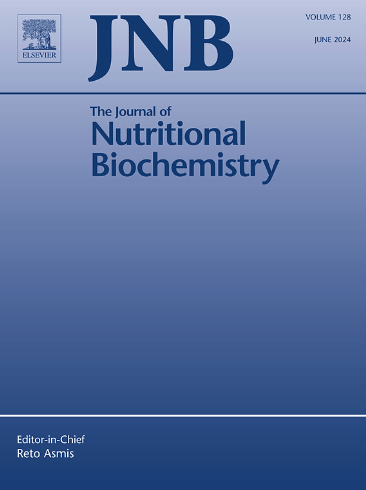柠檬酸盐消耗增加通过影响肠道微生物群和激活HIF-1α增加C57BL/6J小鼠结肠通透性。
IF 4.8
2区 医学
Q1 BIOCHEMISTRY & MOLECULAR BIOLOGY
引用次数: 0
摘要
柠檬酸盐是一种被广泛使用的食品添加剂,几乎被添加到所有工业化的食品中,无论加工程度如何。事实上,自从枸橼酸盐被列为“公认的安全”产品,没有使用限制以来,它的消费量多年来一直在增加。最近,我们已经证明小鼠柠檬酸盐消耗增加会影响生理,损害葡萄糖耐量并促进低度全身炎症。在这里,我们用每克食物添加40毫克柠檬酸盐的标准食物喂养小鼠24小时或12周,这是标准食物量的两倍,并评估了这些动物的结肠和肠道微生物群。增加24小时或12周的柠檬酸盐摄入量对小鼠的影响相似,如糖耐量降低,粘膜屏障变薄,结肠通透性和炎症增加。此外,肠道菌群数量也发生了显著变化,细菌总数增加,变异性减少,显示出类似肥胖的特征。此外,柠檬酸消耗的增加上调了质膜柠檬酸转运蛋白SLC13a5、HIF-1α和ATP:柠檬酸裂解酶,促进了细胞内柠檬酸代谢。最后,我们提出柠檬酸盐消耗增加会增加胞质乙酰辅酶a的形成,促进脂质合成和蛋白质和核酸的乙酰化,从而有利于表观遗传修饰。本文章由计算机程序翻译,如有差异,请以英文原文为准。
Enhanced citrate consumption increases colon permeability in C57BL/6J mice by affecting gut microbiota and activating HIF-1α
Citrate is a ubiquitously used food additive added to almost all industrialized alimentary product regardless the degree of processing. Indeed, citrate consumption has increased over the years since it is classified as a “generally recognized as safe” product, with no limitations to its use. Recently, we have shown that enhanced citrate consumption by mice impact physiology, impairing glucose tolerance and promoting low-grade systemic inflammation. Here, we treated mice for 24 hours or 12 weeks with standard chow diet enhanced with 40 mg citrate per gram of food, doubling its standard amount, and evaluated the colon of these animals and gut microbiota. Enhance citrate consumption for both 24 hours or 12 weeks promoted similar outcomes on mouse, as impairing glucose tolerance, thinning mucosal barrier and augmenting colon permeability and inflammation. Moreover, there is a robust change in gut microbiota population, that increased total bacteria with decreased variability, showing an obesogenic-like profile. Furthermore, enhanced citrate consumption upregulated the plasma membrane citrate transporter SLC13a5, HIF-1α and ATP: citrate lyase, boosting cytosolic citrate metabolism. In the end, we propose that enhanced citrate consumption increases cytosolic Acetyl-CoA formation, promoting lipid synthesis and acetylation of proteins and nucleic acids, and thus favoring epigenetic modifications.
求助全文
通过发布文献求助,成功后即可免费获取论文全文。
去求助
来源期刊

Journal of Nutritional Biochemistry
医学-生化与分子生物学
CiteScore
9.50
自引率
3.60%
发文量
237
审稿时长
68 days
期刊介绍:
Devoted to advancements in nutritional sciences, The Journal of Nutritional Biochemistry presents experimental nutrition research as it relates to: biochemistry, molecular biology, toxicology, or physiology.
Rigorous reviews by an international editorial board of distinguished scientists ensure publication of the most current and key research being conducted in nutrition at the cellular, animal and human level. In addition to its monthly features of critical reviews and research articles, The Journal of Nutritional Biochemistry also periodically publishes emerging issues, experimental methods, and other types of articles.
 求助内容:
求助内容: 应助结果提醒方式:
应助结果提醒方式:


